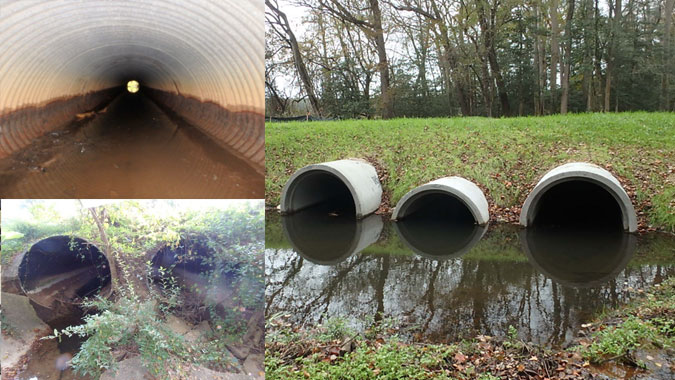
| Name of Agency | Delaware Department of Transportation (DelDOT) |
|---|---|
| Location | Statewide |
| Project Delivery Method | Design-Bid-Build (D-B-B), Indefinite Delivery/Indefinite Quantity (IDIQ), Design-Build (D-B) |
| Procurement Method | Low Bid (LB), Best Value (BV) |
| Total Project Cost |
Funding has ranged from $1 million to $3 million per year |
| Funding Source |
|
| Construction Schedule | The culvert replacement bundle program had varying durations. Each location was assigned a construction schedule based on the work required to complete the job. |
| Project Description | In the early 2000s, DelDOT discovered that it had a serious problem with deterioration of large pipe culverts. Due to a decision made in the 1980s to remove them from the bridge inventory, hundreds of large culverts in poor condition had escaped inspection for decades. DelDOT assessed the problem and began a bundling program to replace the culverts quickly. The first attempt to speed up project delivery and achieve cost savings via economies of scale was to create small bundles of culvert replacements. Plans were prepared, and projects were awarded based on LB. This worked, but improvements to the process were still required. Some of the small bundles were delayed because of issues at a single location (i.e., right-of-way, utilities, etc.). In addition, DelDOT looked for ways to accelerate the time necessary to develop plans and procure a contract. This led to the second contracting method, which was the development of an IDIQ contract. In this contract, DelDOT developed detailed plans for five locations that were shovel-ready. Additional quantities were included for locations to be determined at a later date. In all, 17 additional locations were added successfully. The contractor that won the bid was involved in the design of the additional locations, which helped to determine utility relocations, stream diversion plans, right-of-way needs, and schedules. The IDIQ methodology helped expedite delivery with this bridge bundle, as DelDOT did not need to undergo the procurement process for each additional location. The procurement method used for this project was LB. In an effort to move even more quickly, DelDOT created a D-B contract that included the replacement of 28 culverts under one contract. The successful D-B team was responsible for all aspects of the project, including plan preparation, utility coordination, permit acquisition, and right-of-way negotiations. The procurement method used for this project was BV, which took into consideration both price and the qualifications of the team. In total, for over 10 years, DelDOT has spent between $1 million and $3 million per year on its culvert replacement bridge bundles. Even with the very simple nature of the work, the contracting methods that gave the contractor input during the design stage were beneficial for the Department. Costs per location were comparable across all three contracting methods. |
| Project Website | None |
| Program Goals | Goal for culvert bundling contracts is to reduce the number of culverts in poor condition as quickly as possible. |
|---|---|
| Bridge Selection Criteria | Pipe culverts with over 20 ft2 of opening in poor condition that can be replaced in kind with pipes. |
| Delivery and Procurement Method |
|
| Funding Sources, Financing Strategy |
|
| Environmental, Right-of-Way, and Utility Considerations |
|
| Risks |
|
| Owner Management/Quality Assurance |
|
| Stakeholder Communication | Communication is the same as any other project. For the D-B contract, the D-B team is responsible for communication with the affected community. |